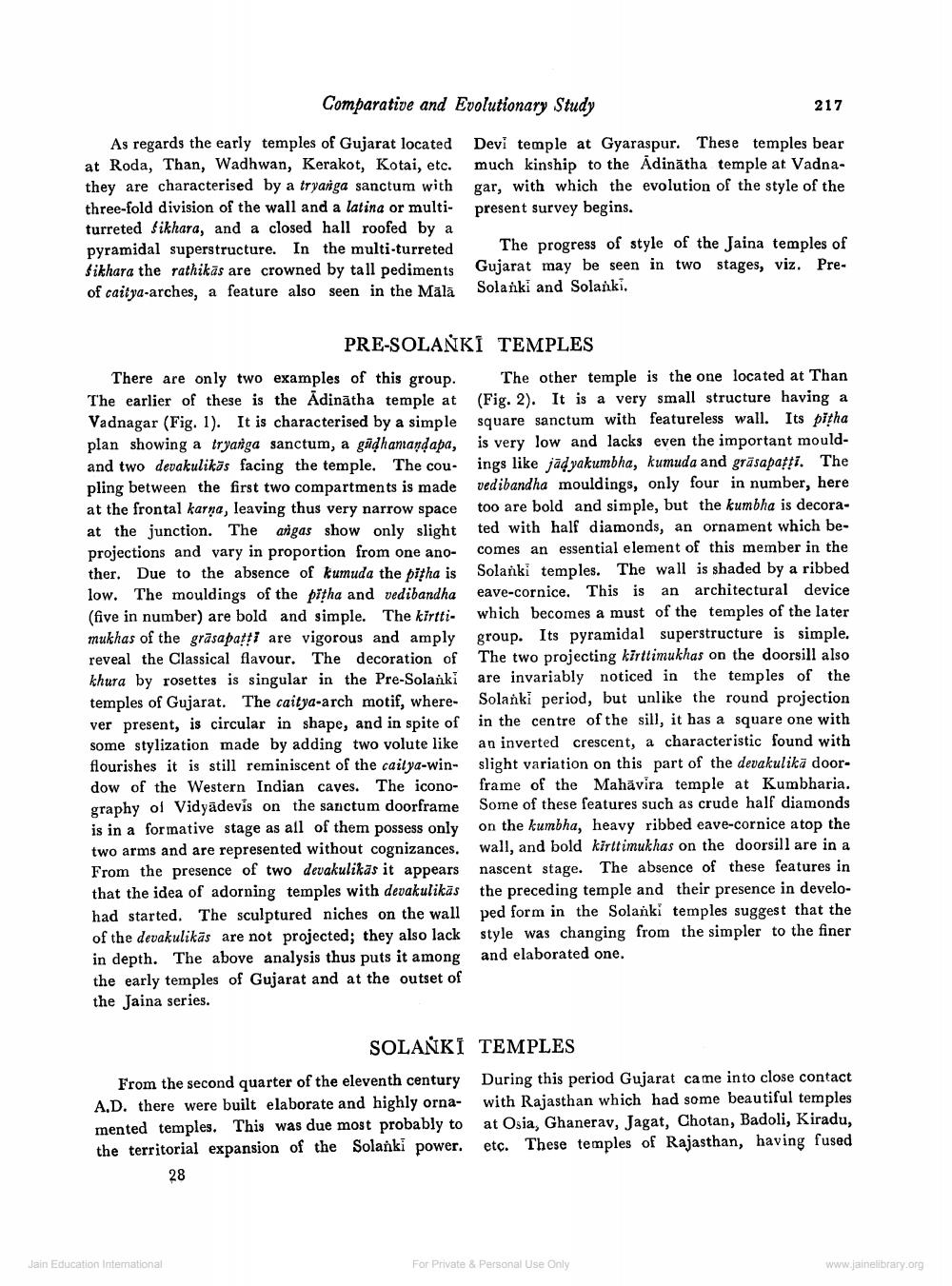________________
Comparative and Evolutionary Study
217
As regards the early temples of Gujarat located Devi temple at Gyaraspur. These temples bear at Roda, Than, Wadhwan, Kerakot, Kotai, etc. much kinship to the Adinātha temple at Vadnathey are characterised by a tryaniga sanctum with gar, with which the evolution of the style of the three-fold division of the wall and a latina or multi- present survey begins. turreted Sikhara, and a closed hall roofed by a pyramidal superstructure. In the multi-turreted The progress of style of the Jaina temples of sikhara the rathikās are crowned by tall pediments Gujarat may be seen in two stages, viz. Preof caitya-arches, a feature also seen in the Mālā Solanki and Solanki,
PRE-SOLANKI TEMPLES There are only two examples of this group. The other temple is the one located at Than The earlier of these is the Adinātha temple at (Fig. 2). It is a very small structure having a Vadnagar (Fig. 1). It is characterised by a simple square sanctum with featureless wall. Its pitha plan showing a tryanga sanctum, a gādhamandapa, is very low and lacks even the important mouldand two devakulikās facing the temple. The cou- ings like jāļyakumbha, kumuda and grāsapatti. The pling between the first two compartments is made vedibandha mouldings, only four in number, here at the frontal karna, leaving thus very narrow space too are bold and simple, but the kumbha is decoraat the junction. The angas show only slight ted with half diamonds, an ornament which beprojections and vary in proportion from one ano- comes an essential element of this member in the ther. Due to the absence of kumuda the pitha is Solanki temples. The wall is shaded by a ribbed low. The mouldings of the pitha and vedibandha eave-cornice. This is an architectural device (five in number) are bold and simple. The kirtti- which becomes a must of the temples of the later mukhas of the grāsapatti are vigorous and amply group. Its pyramidal superstructure is simple. reveal the Classical flavour. The decoration of The two projecting kirttimukhas on the doorsill also khura by rosettes is singular in the Pre-Solanki are invariably noticed in the temples of the temples of Gujarat. The caitya-arch motif, where- Solanki period, but unlike the round projection ver present, is circular in shape, and in spite of in the centre of the sill, it has a square one with some stylization made by adding two volute like an inverted crescent, a characteristic found with flourishes it is still reminiscent of the caitya-win- slight variation on this part of the devakulikā doordow of the Western Indian caves. The icono- frame of the Mahavira temple at Kumbharia. graphy of Vidyādevis on the sanctum doorframe Some of these features such as crude half diamonds is in a formative stage as all of them possess only on the kumbha, heavy ribbed eave-cornice atop the two arms and are represented without cognizances. wall, and bold kiritimukhas on the doorsill are in a From the presence of two devakulikās it appears nascent stage. The absence of these features in that the idea of adorning temples with devakulikās the preceding temple and their presence in develohad started. The sculptured niches on the wall ped form in the Solanki temples suggest that the of the devakulikās are not projected; they also lack style was changing from the simpler to the finer in depth. The above analysis thus puts it among and elaborated one. the early temples of Gujarat and at the outset of the Jaina series.
SOLANKI TEMPLES From the second quarter of the eleventh century During this period Gujarat came into close contact A.D. there were built elaborate and highly orna- with Rajasthan which had some beautiful temples mented temples. This was due most probably to at Osia, Ghanerav, Jagat, Chotan, Badoli, Kiradu, the territorial expansion of the Solanki power. etc. These temples of Rajasthan, having fused
28
Jain Education Interational
For Private & Personal Use Only
www.jainelibrary.org




